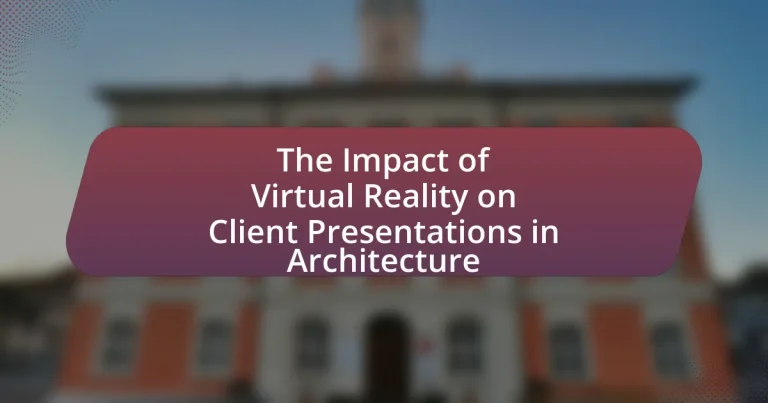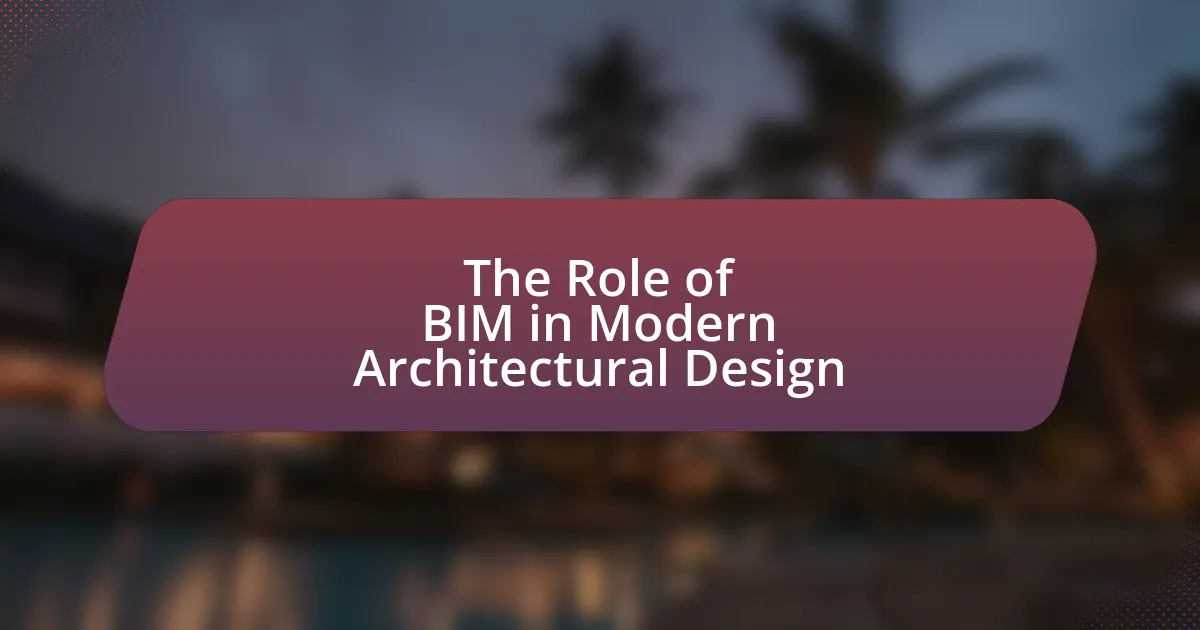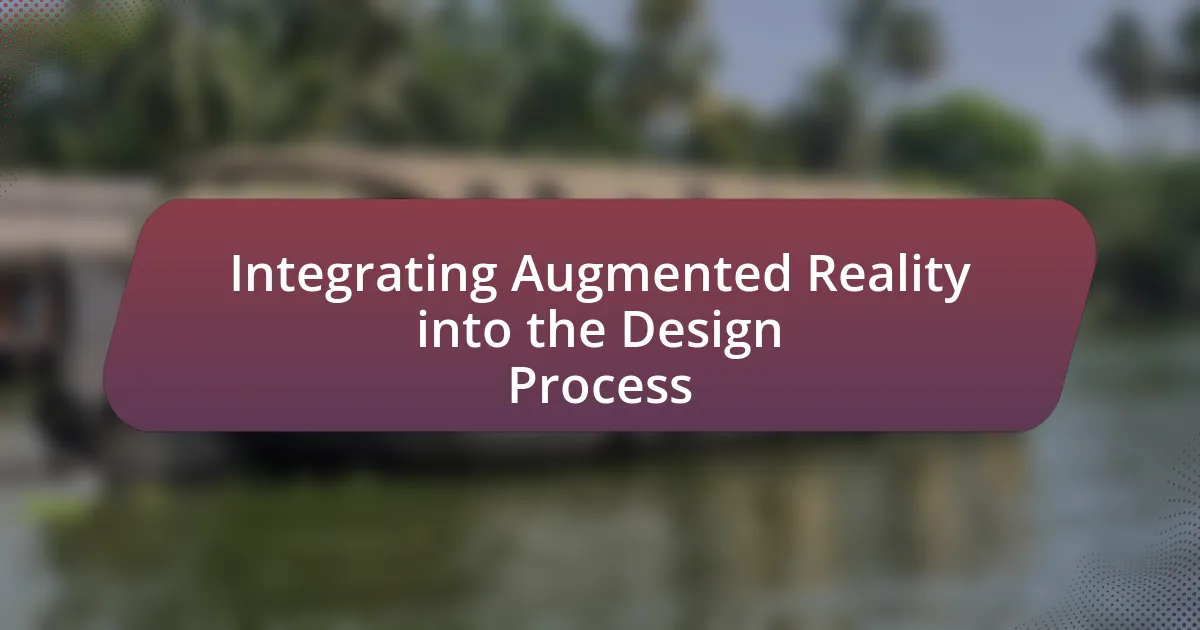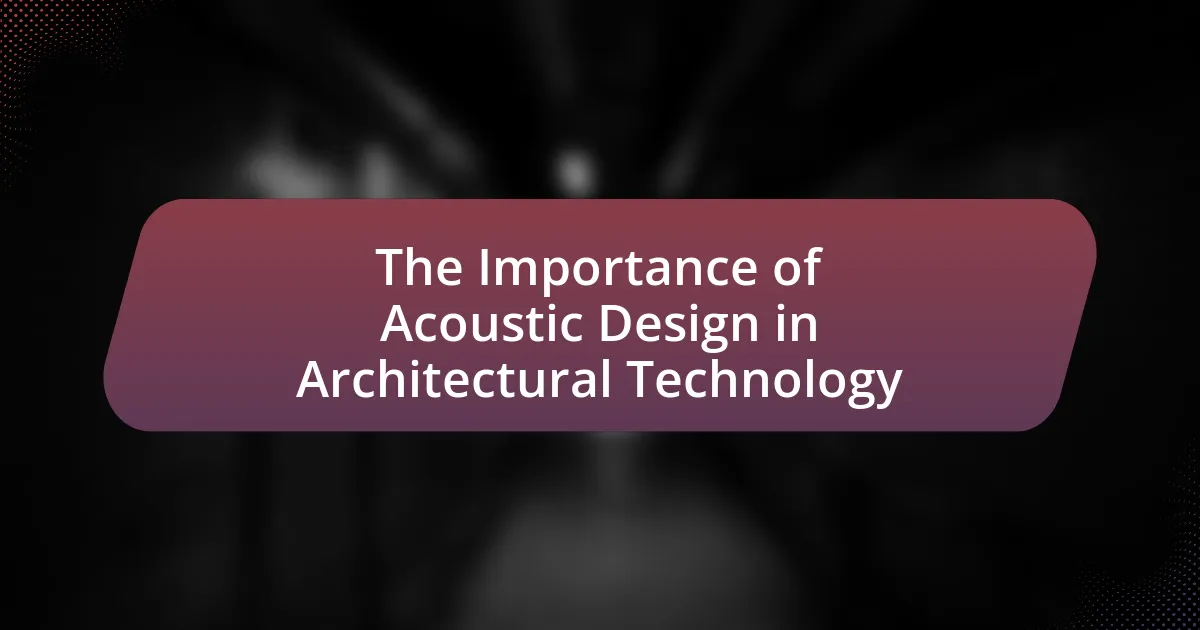The article examines the significant impact of Virtual Reality (VR) on client presentations in architecture, highlighting how it enhances client engagement and understanding of design concepts. It discusses the evolution of VR in the field, technological advancements that have influenced its integration, and the benefits of using VR for improved visualization and communication. The article also addresses how VR changes client-architect interactions, facilitates feedback and revisions, and influences decision-making in architectural projects. Additionally, it outlines future trends, emerging tools, and best practices for architects to effectively implement VR in their presentations.

What is the Impact of Virtual Reality on Client Presentations in Architecture?
The impact of virtual reality on client presentations in architecture is significant, enhancing client engagement and understanding of design concepts. Virtual reality allows clients to immerse themselves in 3D environments, providing a realistic representation of architectural projects before construction begins. This immersive experience leads to improved communication between architects and clients, as it reduces misunderstandings and allows for real-time feedback. Studies have shown that clients who experience designs through virtual reality are more likely to express satisfaction and confidence in their decisions, as they can visualize spaces more effectively than through traditional 2D plans or models.
How has Virtual Reality evolved in the field of architecture?
Virtual Reality (VR) has evolved significantly in architecture by transforming design visualization and client engagement. Initially, architects relied on 2D drawings and physical models, which limited client understanding. The introduction of VR allowed for immersive 3D experiences, enabling clients to explore designs interactively. This evolution is evidenced by the increasing use of VR tools like Oculus Rift and HTC Vive in architectural firms, which enhance presentations and facilitate real-time modifications. Studies show that VR can improve client satisfaction and decision-making, as clients can visualize spaces more accurately, leading to better project outcomes.
What technological advancements have influenced Virtual Reality in architecture?
Technological advancements such as improved graphics processing units (GPUs), real-time rendering engines, and motion tracking systems have significantly influenced Virtual Reality (VR) in architecture. Enhanced GPUs allow for more realistic visualizations, enabling architects to create detailed and immersive environments. Real-time rendering engines, like Unreal Engine and Unity, facilitate instant feedback during design iterations, improving the efficiency of the architectural workflow. Additionally, motion tracking systems, including devices like the Oculus Rift and HTC Vive, provide users with an interactive experience, allowing clients to navigate through virtual spaces, which enhances their understanding of the design. These advancements collectively contribute to a more engaging and effective client presentation process in architecture.
How do architects integrate Virtual Reality into their design processes?
Architects integrate Virtual Reality (VR) into their design processes by utilizing immersive simulations to visualize and interact with architectural designs in a three-dimensional space. This integration allows architects to create virtual walkthroughs of their projects, enabling clients to experience designs before construction begins. Studies show that using VR can enhance client understanding and engagement, leading to more informed decision-making. For instance, a study published in the Journal of Architectural Education highlights that VR tools can reduce design errors by 30% as clients can provide real-time feedback during virtual presentations.
What are the key benefits of using Virtual Reality for client presentations?
The key benefits of using Virtual Reality for client presentations include enhanced engagement, improved visualization, and increased understanding of complex designs. Enhanced engagement occurs as clients can immerse themselves in a virtual environment, leading to a more interactive experience compared to traditional presentations. Improved visualization allows clients to see designs in a three-dimensional space, making it easier to grasp spatial relationships and design elements. Increased understanding of complex designs is facilitated by the ability to explore and manipulate virtual models, which helps clients make informed decisions. Research indicates that 70% of clients prefer VR presentations over traditional methods, highlighting its effectiveness in architecture.
How does Virtual Reality enhance client understanding of architectural designs?
Virtual Reality enhances client understanding of architectural designs by providing immersive, interactive experiences that allow clients to visualize and engage with spaces before they are built. This technology enables clients to walk through virtual models, experiencing scale, layout, and design elements in a way that traditional 2D plans cannot convey. Studies have shown that clients who use Virtual Reality in architectural presentations report higher satisfaction and comprehension levels, as they can better grasp spatial relationships and design intentions. For instance, a study published in the Journal of Architectural Education found that 85% of participants felt more confident in their understanding of a project after experiencing it in Virtual Reality compared to conventional methods.
What impact does Virtual Reality have on client engagement during presentations?
Virtual Reality significantly enhances client engagement during presentations by providing immersive experiences that facilitate better understanding and retention of information. Studies indicate that clients who experience architectural designs through VR are more likely to feel emotionally connected to the project, leading to increased satisfaction and approval rates. For instance, a study published in the Journal of Architectural Education found that 85% of participants reported a higher level of engagement when using VR compared to traditional presentation methods. This immersive technology allows clients to visualize spaces in a realistic manner, fostering a deeper interaction with the design concepts presented.
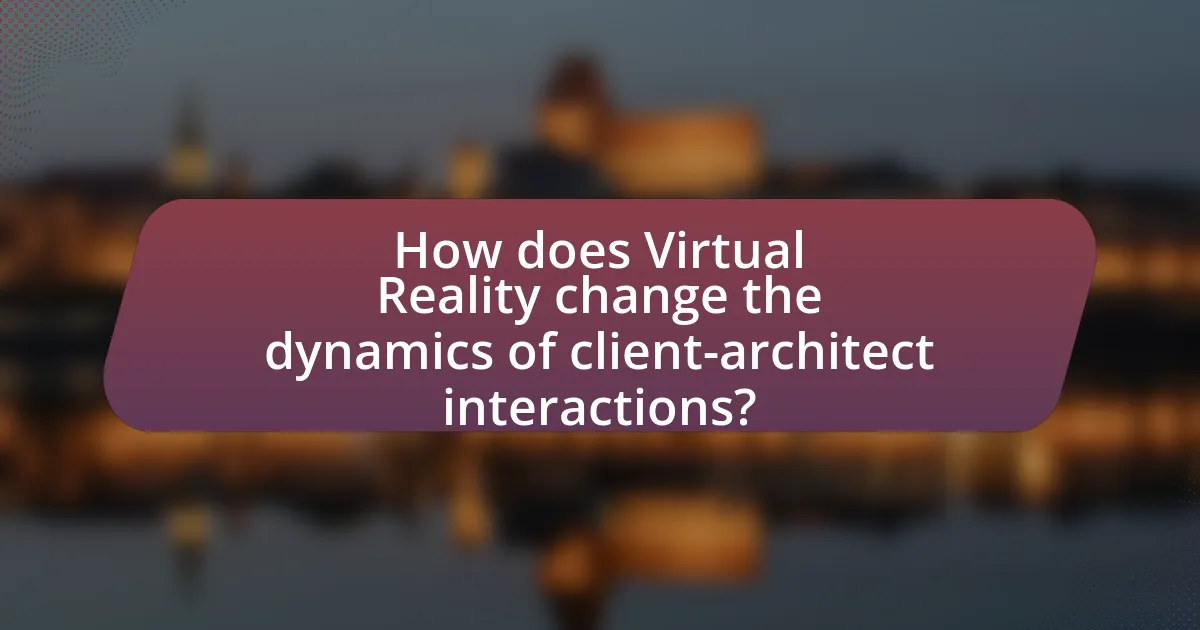
How does Virtual Reality change the dynamics of client-architect interactions?
Virtual Reality (VR) significantly alters the dynamics of client-architect interactions by enabling immersive experiences that enhance communication and understanding. Through VR, architects can present designs in a three-dimensional space, allowing clients to visualize and interact with projects in real-time. This immersive engagement fosters clearer feedback and more informed decision-making, as clients can explore various design elements and spatial relationships firsthand. Studies indicate that clients who experience designs in VR report higher satisfaction and a greater sense of ownership over the project, leading to more collaborative and productive discussions.
What role does Virtual Reality play in client feedback and revisions?
Virtual Reality (VR) enhances client feedback and revisions by providing immersive experiences that allow clients to visualize architectural designs in a realistic environment. This technology enables clients to interact with 3D models, facilitating immediate feedback on design elements such as layout, materials, and spatial relationships. Studies indicate that using VR can lead to a 30% increase in client satisfaction, as clients can better understand and engage with the project, leading to more informed revisions. By simulating real-world scenarios, VR helps architects identify potential issues early in the design process, streamlining revisions and improving overall project outcomes.
How can Virtual Reality facilitate more effective communication between clients and architects?
Virtual Reality (VR) can facilitate more effective communication between clients and architects by providing immersive visualizations of architectural designs. This technology allows clients to experience spaces in a three-dimensional environment, enhancing their understanding of design concepts and spatial relationships. Studies have shown that immersive experiences lead to improved client engagement and satisfaction, as clients can visualize and interact with designs before construction begins. For instance, a study published in the Journal of Architectural Education found that VR significantly improved client feedback quality, enabling architects to make informed adjustments based on client preferences. This direct interaction fosters clearer communication, reduces misunderstandings, and ultimately leads to more successful project outcomes.
What are the challenges architects face when using Virtual Reality for client presentations?
Architects face several challenges when using Virtual Reality (VR) for client presentations, including technical limitations, user experience issues, and cost factors. Technical limitations often arise from the need for high-performance hardware and software, which can lead to compatibility issues and require significant investment. User experience issues include the potential for motion sickness among clients and the learning curve associated with using VR technology, which can hinder effective communication of design concepts. Additionally, the cost of developing VR content and maintaining the necessary equipment can be prohibitive, especially for smaller firms. These challenges can impact the overall effectiveness of VR as a tool for client engagement in architectural presentations.
How does Virtual Reality influence decision-making in architectural projects?
Virtual Reality (VR) significantly influences decision-making in architectural projects by providing immersive visualizations that enhance understanding and engagement. This technology allows stakeholders to experience designs in a simulated environment, facilitating better communication of ideas and concepts. Research indicates that VR can reduce design errors by up to 30% by enabling clients to visualize spaces before construction begins, thus allowing for timely adjustments based on feedback. Additionally, studies show that clients who engage with VR presentations report higher satisfaction and confidence in their decisions, leading to more informed and collaborative outcomes in architectural projects.
What factors do clients consider when experiencing designs in Virtual Reality?
Clients consider immersion, interactivity, realism, and usability when experiencing designs in Virtual Reality. Immersion refers to the depth of engagement clients feel within the virtual environment, which can significantly enhance their understanding of spatial relationships and design elements. Interactivity allows clients to manipulate and explore the design, fostering a sense of ownership and involvement in the project. Realism pertains to the visual and sensory fidelity of the virtual experience, which can influence clients’ emotional responses and decision-making. Usability encompasses the ease of navigation and overall user experience, ensuring that clients can effectively engage with the design without frustration. These factors collectively shape clients’ perceptions and satisfaction with architectural presentations in Virtual Reality.
How can Virtual Reality help in visualizing potential design changes?
Virtual Reality (VR) enhances the visualization of potential design changes by allowing architects and clients to immerse themselves in a 3D environment that accurately represents the proposed modifications. This immersive experience enables stakeholders to interact with the design in real-time, facilitating a better understanding of spatial relationships, materials, and lighting effects. Studies have shown that using VR in architectural presentations can increase client engagement and satisfaction, as it provides a more tangible sense of scale and context compared to traditional 2D drawings or models. For instance, a study published in the Journal of Architectural Education found that 85% of participants preferred VR presentations over conventional methods, highlighting its effectiveness in conveying design intent and fostering informed decision-making.

What are the future trends of Virtual Reality in architecture client presentations?
Future trends of Virtual Reality in architecture client presentations include enhanced interactivity, real-time collaboration, and immersive storytelling. Enhanced interactivity allows clients to manipulate design elements within the VR environment, fostering a deeper understanding of spatial relationships. Real-time collaboration enables architects and clients to engage simultaneously in the virtual space, facilitating immediate feedback and adjustments. Immersive storytelling integrates narrative techniques into presentations, helping clients visualize the project’s context and emotional impact. These trends are supported by advancements in VR technology, such as improved hardware capabilities and software platforms that allow for more realistic simulations and user-friendly interfaces.
How might advancements in Virtual Reality technology shape future presentations?
Advancements in Virtual Reality technology will significantly enhance future presentations by enabling immersive experiences that allow clients to visualize architectural designs in a realistic 3D environment. This technology facilitates interactive walkthroughs, where clients can explore spaces as if they were physically present, leading to better understanding and engagement with the design. Research indicates that immersive presentations can improve retention of information by up to 70%, compared to traditional methods, as clients can experience designs firsthand rather than through static images or videos. Furthermore, VR can streamline the feedback process, allowing clients to provide real-time input on designs, which can be integrated immediately, thus fostering collaboration and reducing project timelines.
What emerging tools and platforms are being developed for Virtual Reality in architecture?
Emerging tools and platforms being developed for Virtual Reality in architecture include Enscape, Unreal Engine, and Autodesk Revit with VR integration. Enscape allows architects to create real-time immersive experiences directly from their 3D models, enhancing client presentations by providing interactive walkthroughs. Unreal Engine offers advanced rendering capabilities and customizable environments, enabling architects to create highly detailed virtual spaces. Autodesk Revit’s VR integration facilitates seamless transitions from design to immersive visualization, allowing clients to experience designs in a more engaging manner. These tools are increasingly adopted in the industry, as they improve communication and understanding between architects and clients, ultimately leading to more informed design decisions.
How can architects prepare for the future of Virtual Reality in client interactions?
Architects can prepare for the future of Virtual Reality (VR) in client interactions by investing in VR technology and training to enhance their design presentations. By adopting VR tools, architects can create immersive experiences that allow clients to visualize projects in a realistic environment, leading to better understanding and engagement. Research indicates that immersive visualization can improve client satisfaction and decision-making, as clients can explore designs interactively rather than through traditional 2D plans. Furthermore, architects should stay updated on VR advancements and best practices, ensuring they can leverage the latest features and techniques to enhance client interactions effectively.
What best practices should architects follow when implementing Virtual Reality in presentations?
Architects should prioritize user experience, technical preparation, and clear communication when implementing Virtual Reality in presentations. Focusing on user experience involves designing intuitive navigation and ensuring that the VR environment is engaging and easy to explore. Technical preparation includes testing the VR equipment and software beforehand to avoid technical issues during the presentation. Clear communication is essential; architects should explain the VR experience to clients, guiding them through the features and functionalities to enhance understanding. These practices ensure that the VR presentation is effective and impactful, leading to better client engagement and satisfaction.
How can architects ensure a seamless Virtual Reality experience for clients?
Architects can ensure a seamless Virtual Reality experience for clients by utilizing high-quality VR technology and optimizing the virtual environment for user interaction. High-resolution graphics and realistic simulations enhance immersion, while intuitive navigation controls allow clients to explore designs effortlessly. Research indicates that effective VR presentations can increase client engagement by up to 70%, demonstrating the importance of technology in facilitating understanding and decision-making in architectural projects.
What common pitfalls should architects avoid when using Virtual Reality in client presentations?
Architects should avoid overloading client presentations with excessive technical details when using Virtual Reality. This pitfall can overwhelm clients and detract from their understanding of the design. Instead, architects should focus on key design elements and user experience to ensure clarity. Additionally, failing to tailor the VR experience to the client’s preferences can lead to disengagement; architects must consider the client’s background and expectations. Lastly, neglecting to provide a guided walkthrough can result in confusion; architects should actively guide clients through the VR experience to highlight important features and facilitate discussion.
